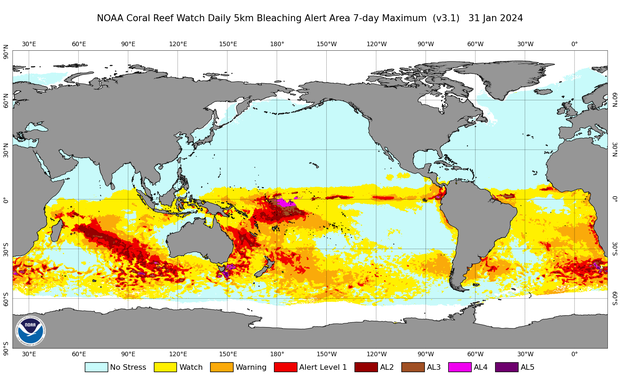[ad_1]
Temperatures in parts of the world got so hot last year that it caused certain areas of the ocean to experience hot tub-level temperatures, which killed off essential coral reefs. The situation was unprecedented, to the point that researchers had to add three new levels to a coral bleaching warning system in an attempt to better protect marine life.
The National Oceanic and Atmospheric Administration’s Coral Reef Watch program, which uses satellites and models to monitor coral reef systems worldwide, said it revamped its bleaching alert system “in response to 2023’s unprecedented marine heatwaves.”
“The revised system provides additional detail to help coral reef managers prepare for and take action during times of extreme heat stress,” the program said on social media.
Coral bleaching occurs when the animals become overly stressed by changes in temperature, light or nutrients. When that happens, the corals expel the algae that reside within their tissues, leaving them with a white color, or as NOAA says, “bleached and vulnerable.” Bleached corals are not necessarily dead, but they rely on algae to provide them with food, so when the algae leave, corals are more susceptible to death.
According to NOAA, “increased ocean temperature caused by climate change is the leading cause of coral bleaching.”
Prior to the update, there were only two bleaching alert levels. The system now ranges from level one, “risk of reef-wide bleaching,” to level five, “risk of near complete mortality.” As of Thursday, a satellite image of heat stress alerts showed widespread coral bleaching watches in effect across the world, with several areas experiencing alert levels one and two, and at least one area in the Pacific Ocean experiencing levels four and five.
NOAA Coral reef Watch
“Significant heat stress is building across the southern hemisphere,” NOAA’s Coral Program posted on social media, saying that coral bleaching is expected “throughout much of the Indian Ocean and the central equatorial and southwestern Pacific, including the Great Barrier Reef,” over the next few months.
The continuation of El Niño is certain to play a role. In its January update, NOAA said the weather phenomenon is “very likely close to peak strength and is likely to continue for the next few months.” It will gradually weaken, but its “impacts to global climate will continue,” NOAA said.
El Niño typically creates warmer sea surface temperatures in the Pacific Ocean. Those temperatures usually peak between December and January. In December, NOAA found that the sea surface temperature in a key monitoring region in the Pacific was 2.1 degrees Celsius above the 1991-2020 average for that area.
The revamped bleaching alert system comes after 2023 was designated as the hottest year ever recorded. Last summer, it was so warm that some spots off the Florida coast saw ocean temperatures surpass 100 degrees Fahrenheit, even reaching temperatures used in hot tubs. In July, a coral reef restoration site off the coast faced an “unimaginable” fate, according to researchers – “100% coral mortality.”
“The vibrant coral reefs of Florida, crucial to the local community and the state’s economy, are facing a severe and urgent crisis due to soaring water temperatures,” the Coral Restoration Foundation said at the time of the discovery. “The potential loss of coral populations within the Florida Keys National Marine Sanctuary is quickly becoming an alarming reality.”


